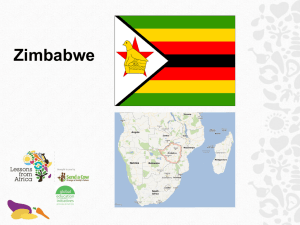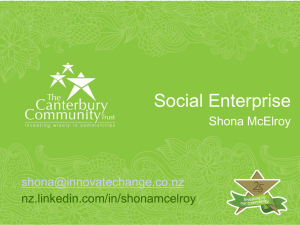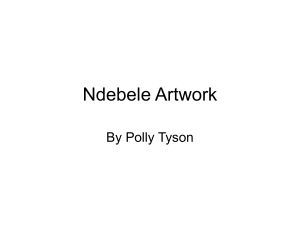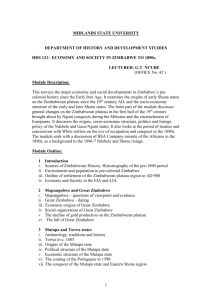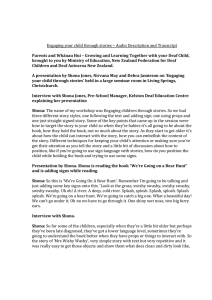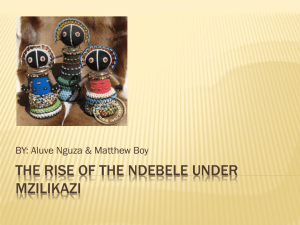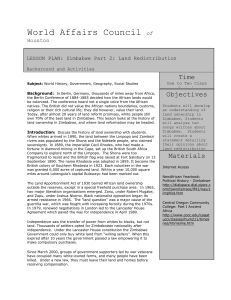Document 10465227
advertisement
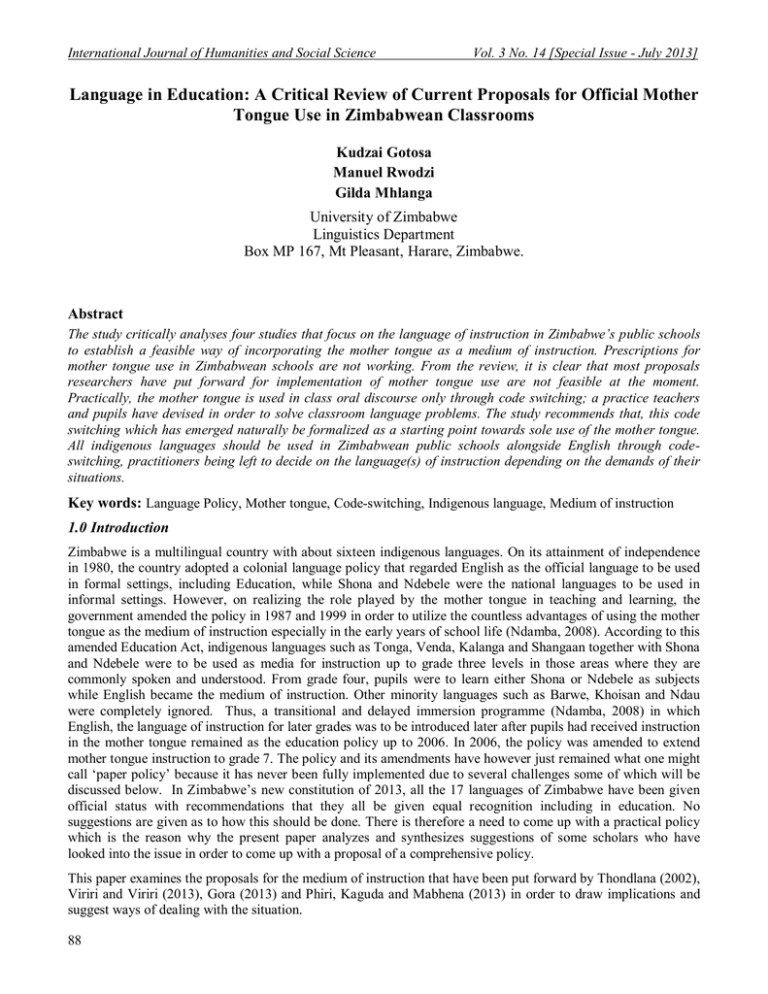
International Journal of Humanities and Social Science Vol. 3 No. 14 [Special Issue - July 2013] Language in Education: A Critical Review of Current Proposals for Official Mother Tongue Use in Zimbabwean Classrooms Kudzai Gotosa Manuel Rwodzi Gilda Mhlanga University of Zimbabwe Linguistics Department Box MP 167, Mt Pleasant, Harare, Zimbabwe. Abstract The study critically analyses four studies that focus on the language of instruction in Zimbabwe’s public schools to establish a feasible way of incorporating the mother tongue as a medium of instruction. Prescriptions for mother tongue use in Zimbabwean schools are not working. From the review, it is clear that most proposals researchers have put forward for implementation of mother tongue use are not feasible at the moment. Practically, the mother tongue is used in class oral discourse only through code switching; a practice teachers and pupils have devised in order to solve classroom language problems. The study recommends that, this code switching which has emerged naturally be formalized as a starting point towards sole use of the mother tongue. All indigenous languages should be used in Zimbabwean public schools alongside English through codeswitching, practitioners being left to decide on the language(s) of instruction depending on the demands of their situations. Key words: Language Policy, Mother tongue, Code-switching, Indigenous language, Medium of instruction 1.0 Introduction Zimbabwe is a multilingual country with about sixteen indigenous languages. On its attainment of independence in 1980, the country adopted a colonial language policy that regarded English as the official language to be used in formal settings, including Education, while Shona and Ndebele were the national languages to be used in informal settings. However, on realizing the role played by the mother tongue in teaching and learning, the government amended the policy in 1987 and 1999 in order to utilize the countless advantages of using the mother tongue as the medium of instruction especially in the early years of school life (Ndamba, 2008). According to this amended Education Act, indigenous languages such as Tonga, Venda, Kalanga and Shangaan together with Shona and Ndebele were to be used as media for instruction up to grade three levels in those areas where they are commonly spoken and understood. From grade four, pupils were to learn either Shona or Ndebele as subjects while English became the medium of instruction. Other minority languages such as Barwe, Khoisan and Ndau were completely ignored. Thus, a transitional and delayed immersion programme (Ndamba, 2008) in which English, the language of instruction for later grades was to be introduced later after pupils had received instruction in the mother tongue remained as the education policy up to 2006. In 2006, the policy was amended to extend mother tongue instruction to grade 7. The policy and its amendments have however just remained what one might call ‘paper policy’ because it has never been fully implemented due to several challenges some of which will be discussed below. In Zimbabwe’s new constitution of 2013, all the 17 languages of Zimbabwe have been given official status with recommendations that they all be given equal recognition including in education. No suggestions are given as to how this should be done. There is therefore a need to come up with a practical policy which is the reason why the present paper analyzes and synthesizes suggestions of some scholars who have looked into the issue in order to come up with a proposal of a comprehensive policy. This paper examines the proposals for the medium of instruction that have been put forward by Thondlana (2002), Viriri and Viriri (2013), Gora (2013) and Phiri, Kaguda and Mabhena (2013) in order to draw implications and suggest ways of dealing with the situation. 88 The Special Issue on Social Science Research © Centre for Promoting Ideas, USA www.ijhssnet.com 2.0 What scholars are suggesting as a way forward Thondlana (2002) addresses the question of which language(s) to use for teaching and learning in a bilingual/multilingual context like that of Zimbabwe. She advocates for the use of indigenous languages in primary education. Thondlana argues that pupils are exposed to a second language before they have fully mastered the first language which jeopardizes proficiency in the mother tongue because teachers and parents focus on learning English at school and home. She also observes and that in some cases, children come to school proficient in their mother-tongues but soon begin to lose this as the focus is shifted to developing proficiency in English both at school and home. She therefore suggests that the period of mother tongue instruction be extended from grade 3 to grade 7 in order to give adequate time for the acquisition and development of cognitive, affective and social skills through the mother tongue. What is not clear is when English should be introduced as the medium of instruction. Thondlana’s (2002) suggestion of extension of mother tongue instruction has since been incorporated in the 2006 amended education act even though examinations are still being written in English. One can note here however that this amendment was made despite reports that the use of Shona and Ndebele as well as selected minority languages up to grade three was not being implemented as revealed by studies that were carried out after the amendment in 1987 (Thondlana 2002, Ndamba 2008, Phiri, Kaguda and Mabhena, 2013). One reason for the failure of implementation is the problem of negative attitudes of parents and pupils which has since been reported (Chiwome and Thondlana, 1990). Studies carried out as recently as 2013 are still calling for the change of this attitude. No study has yet reported this change. It was found that pupils and parents preferred English as the language of instruction from infant level, despite challenges faced in accessing the curriculum through the use of the second language. This is not a case only unique to Zimbabwe. Mawasha (1996:23) also observes that Black people in South Africa prefer English as a language of learning and teaching even from the earliest years of primary schooling. Not only English has been cited as the reason for failure of implementation but also Shona and Ndebele. Muchenje, Goronga and Bondai (2013) for example, report of Shona being imposed on Nyanja speaking pupils yet the Education Act of 1987 amended in 1990 had officially recognized Nyanja and recommended that it be used up to grade 3 in areas where it is spoken. Further evidence that the original education Act was never fully implemented is also shown by the fact that primary teachers’ training colleges continue to teach students how to teach all subjects (except Shona and Ndebele) at primary school in English and not indigenous languages. One wonders then why the extension from grade 3 to grade 7 should be done given that there was never full implementation of the original Act. Thondlana’s (2002:38) proposal also seems quite difficult to implement. She says: “I envision a situation where, in a Ndebele-English environment, for example, a teacher could choose to use either of the two languages in his or her class or could just code-switch as necessary. Furthermore, students could be free to write their assignments and examinations in the language of their choice.” Firstly, from the above quotation, it is not clear how the two languages should be used; simultaneously? code mixing or code switching? This should be very clear because that is where the problem lies. Researchers should give details of how languages should be used in a multilingual setting such as Zimbabwe’s. Secondly, the author does not specify which languages should be allowed in class apart from Ndebele and English given the fact that from her paper Zimbabwe seems to have 17 languages including English? If she is referring to Ndebele, Shona and English then her proposal fails to “take into account the use of the indigenous languages in education” (Thondlana 2002; 38) which is something that she sets out to do in her study. Shona and Ndebele are not the only indigenous languages of Zimbabwe. If she is referring to all the languages then the question that should be answered is how can that be done? We no longer have homogenous communities where one language is the mother tongue of every pupil. Phiri, Kaguda and Mabhena (2013) for example, report of a situation where in one class there are Ndebele, Shona and English first language speakers. How is appropriate teacher allocation for this situation then supposed to be done? Thus, it will be very difficult, as it will require that teachers be conversant in all the languages in order to be able to teach and assess pupils work. Furthermore, even though Thondlana’s (2002) suggestions have been incorporated in an amendment that should be functional right now, it will take time before enough resources are found to allow for pupils to practically use the mother tongue up to grade seven as required. 89 International Journal of Humanities and Social Science Vol. 3 No. 14 [Special Issue - July 2013] It is now 26 years after the 1987 Education Act, yet there are hardly any content and mathematics books written in indigenous languages for use up to grade three. Even though the policy recommends that Shona and Ndebele be used up to grade 3, teaching and writing in content and mathematics subjects are still being done in English. Yet when indigenous languages were introduced to the lower primary school levels, the intention was to pave the way for the extension to upper grades. But then what has changed to warrant extension to grade 7? This makes it difficult to regard Thondlana’s (2002) proposal as well as the amended act as answers to the language of instruction question for the Zimbabwe education system. Gora (2013) addresses the question of the language of instruction at different levels of education in Zimbabwe. She explores possibilities of using either Shona or Ndebele as languages of instruction alongside English so as to enhance partnership and complementarity between the two major indigenous African languages and the exogenous language of wider communication. Gora (2013) agrees with the Amended Education Act which states that the language of instruction from grade 1 up to 3 should be “any of the three main languages of Zimbabwe, depending on which language is more commonly spoken and understood better by pupils.” From grade 4 up to 7, she suggests that only mathematics and English be taught in English while code-switching and code-mixing with indigenous languages when necessary. This recommendation is made despite the fact that there are studies which report the positives of explaining mathematical concepts in indigenous languages. For the rest of the subjects which are Shona / Ndebele, Religious and Moral Education, Social Studies, Environmental Studies and Physical Education, she suggests that Shona/Ndebele be used. For secondary education, Gora (2013) suggests that Shona or Ndebele be used for instruction in the following subjects: Shona/Ndebele, Bible Knowledge, Geography, History, Metalwork, Fashion and Fabrics, Food and Nutrition, Woodwork, Building and Agriculture. Gora further proposes that, in the meantime, English continues to be the medium of instruction in English Language, Literature in English, Mathematics, all Sciences, Technical Graphics, Economics, Management of Business, Accounts and Commerce at secondary school level. At institutions of higher learning (teachers colleges, polytechnics, vocational training centers and universities) Gora suggests that Shona/Ndebele, Humanities and practical subjects or disciplines should continue to be taught through the indigenous languages. Then Mathematics, English, Sciences and commercials would continue to be offered in English at tertiary level, like at secondary school level. Gora (2013) argues that using either Shona or Ndebele as languages of instruction alongside English in the manner she suggests, which is outlined above, will enhance partnership and complementarity between Shona/Ndebele and English. This is very important and necessary since English is also important for Zimbabweans. However, Gora’s (2013) proposals seem too complex and confusing in that they involve so many changes of language of instruction amongst subjects at different levels. If people had problems with the implementation of simple policies, would they be able to implement Gora’s very complex policy? In addition, the same question we have asked about Thondlana’s proposal still remains: What has been done so far to warrant extension of mother tongue usage to grade 4 and upwards? All the factors we mentioned which militate against Thondlana‘s suggestions apply to Gora’s proposals as well. The original policy enacted at independence in 1980 prescribed that English only be used in the classroom but it was never implemented; people were code-switching and codemixing for different reasons. The Education Act of 1987 which prescribed that indigenous languages be used up to grade three was never fully implemented with English being used from infant grades and all written work being done in English except for shona/Ndebele subjects (Ndamba, 2008 and Thondlana, 2002). The 2006 amendment which requires mother tongue instruction to continue up to grade seven is still not being implemented as shown in studies such as Phiri, Kaguda and Mabhena (2013). What then guarantees that Gora’s suggestions will be implemented? In fact, Gora’s proposals, just as previous studies have noted (Ndamba, 2008) are not for immediate application. There is still need for consultations with relevant stakeholders, since attitude change and resource production and mobilization; issues we have already mentioned which have always been raised as militating against attempts to use the mother tongue in the classroom (Chiwome and Thondlana 1990, Mufanechiya and Mufanechiya 2011, Ndamba 2008) still remain. Gora argues that the country has many intellectuals who can produce resources yet Phiri, Kaguda and Mabhena (2013) lament the degree of slavery, colonialism and neocolonialism which has resulted in the highest degree of plunder which they claim cannot be exorcised overnight. Thus, intellectuals may be there but not the money that is required to enable production of resources. 90 The Special Issue on Social Science Research © Centre for Promoting Ideas, USA www.ijhssnet.com Gora (2013) also suggests that Shona and Ndebele, representing indigenous languages, should be used in the classroom as mother tongues of Zimbabwe. Gora chooses the two languages because they are spoken by the majority of people and they have written material. It is now sixteen years since Shona and Ndebele got privileged and were allowed in the classroom as media of instruction up to grade 3 in addition to being subjects. This should not continue at the expense of other indigenous languages. Some scholars may regard it as ‘tribal mentality’ (Gora 2013) that people should think that other indigenous languages are ignored but that may not be the case. If the mother tongue is important to a pupil in the classroom, then it is important to consider all pupils where possible in an endeavor to help them access the benefits. Muchenje, Goronga and Bondai (2013) for example, regard the teaching of Nyanja/ Chewa in Shona as part of the colonial legacy, where indigenous languages suffered calculated neglect. Viriri (2002) regards it as linguistic hegemony of an indigenous language by another because the result is lack of recognition and development of ignored languages. This practice of imposing Ndebele and Shona on other speakers of minority languages in Zimbabwe has resulted in language shift with some languages becoming endangered, for example, Barwe whose native speakers are forced to use Shona at school and Tshwawo (Khoisan) whose speakers are forced to learn Ndebele at school. Therefore, Shona and Ndebele should not continue to be imposed on all pupils. The question that Phiri, Kaguda and Mabhena (2013) ask still remains relevant: “can these few students be sacrificed for the greater good?” All Zimbabwean pupils should be allowed to utilize their mother tongue where possible. This is also in line with the Zimbabwe Presidential Commission of Inquiry into Education and Training’s 1999 recommendations that “there is need to recognize linguistic rights as human rights which all citizens should enjoy; and there is need to protect and promote respect for all community languages regardless of the number of speakers and their level of development” (Muchenje, Goronga and Bondai 2013; 501). Gora (2013) argues that there are no resources to use for other minority languages. But are there resources to teach all primary subjects from grade 1 up to 7 in Shona and Ndebele right now? Especially now that all the minority languages of Zimbabwe have been given official status in the new constitution of 2013, they should all be recognized in considerations of the language of instruction. Phiri, Kaguda and Mabhena (2013) carried out a study to assess the impact of the medium of instruction on the performance of two Grade 6 classes. They report a lot of code-switching that is occurring in classes between Shona and English even in English and Shona lessons. They also observe that Ndebele speakers and English first language speakers are disadvantaged when teachers code-switch to Shona which they do not understand. This however does not seem to reflect what really happens when teachers’ code-switch and code mix for purposes of giving explanations. They first explain in English and then in Shona because they know that written work will be in English. May be in the cited case Ndebele speakers only are disadvantaged. Phiri, Kaguda and Mabhena (2013) suggest that a multilingual policy be adopted that fosters multilingual competencies. Phiri, Kaguda and Mabhena’s (2013) study enlightens on what is happening in classes and restates what has already been noted by several scholars; the need for a multilingual policy (Shizha 2012). That indigenous languages should be included in the curriculum has long been noted. But how to include them is the question that continues to haunt researchers and many of them evade answering it. Phiri, Kaguda and Mabhena’s (2013) do not suggest how the multilingual policy that can rectify the current situation can be implemented given linguistic diversity that characterizes Zimbabwean schools. In failing to address the question, their study does not provide a solution to the problem. They also foresee failure of their proposal due to colonial mentality and lack of nationalistic feelings. These however are not the only problems. How to practically implement such a program that “accommodates students from various linguistic backgrounds” (Phiri, Kaguda Mabhena 2013; 51) is the major problem. Viriri and Viriri (2013) carried out a study on the language situation in secondary schools and discovered that there is no consistency between the language policy and the real practice on the ground. They report widespread tendencies to use Shona or a mixture of English and Shona, by both teachers and learners in the school although all classroom interactions should officially be mediated through English. Viriri and Viriri (2013) interpret the existence of code-switching as a reflection of the extensive poor proficiency in English amongst teachers and pupils especially in the rural areas. The scholars argue that code-switching is unavoidable as long as a foreign language is the only language of the classroom but it’s not known whether it will be eradicated if indigenous languages replace English. Viriri and Viriri (2013) recommend the consideration of indigenous languages (not Shona only) as media of instruction in education so as to include the majority of Zimbabwean pupils. 91 International Journal of Humanities and Social Science Vol. 3 No. 14 [Special Issue - July 2013] They however, like Phiri, Kaguda and Mabhena (2013), do not give details of how this can be done which unfortunately is the crucial problem. All the four studies reviewed above are really enlightening on the situation on the ground regarding what is happening linguistically in the Zimbabwean classrooms. The proposed policy as amended in 1987, 1999 and 2006 to use English only, to use the mother tongue up to grade 3, and to use the mother tongue up to grade 7 respectively has never received full implementation and cannot at the moment be implemented. Code-switching is the practice that is consistently being noted. Code-switching has since been reported in classrooms (Chitiga 1995). Mufanechiya and Mufanechiya (2011; 195) speaking of mathematics instruction say “currently, in Zimbabwe… in the classroom, teachers have used a language which best conveys skills and concepts be it English or the pupil’s mother tongue or both.” Chiwome and Thondlana (1990) observe that some teachers prefer to use English in the teaching and learning of even Shona, and when given a choice, some students prefer to write their Shona essays in English. Viriri and Viriri’s (2013) findings also indicate that the practice of code switching is common in all the twelve subjects that form the schools’ curricula. Phiri, Kaguda and Mabhena (2013) sum it up all when they observe that the mother tongue of the majority of students in the Zimbabwean context is deeply influenced by the English language which permeates into every aspect of the students' lives. It is true that these manifestly prevalent code-switching and code-mixing are actually symptomatic of what is obtaining in the wider bilingual and multi-lingual Zimbabwean society as has also been reported in media and technology as well as in genres such as poetry, music, film mix and literary texts (Veit-Wild 2009, Mareva and Mapako 2012). Veit Wild (2009) for example, sees it as a widespread phenomenon that forms an intrinsic part of contemporary urban culture in Africa. This prevalence of code-switching has also implications for the implementation of proposals that have been put forward. If (from what Phiri, Kaguda and Mabhena 2013 and Viriri and Viriri 2013 say), code switching is prevalent in schools and has been so since day one, when English was said to be the medium of instruction, then it means that both languages (the mother tongue and English) are needed in the classroom. Because code-switching also occurs in English lessons and in Shona/Ndebele lessons, it is doubtful that if a mother tongue is prescribed as the medium of instruction code-switching will stop. Like the above scholars rightly note, code-switching is unavoidable in a bilingual situation. So what guarantees that Shona/ Ndebele if prescribed as the medium of instruction will be solely used? Right now, are pupils and teachers able to converse using pure Shona/Ndebele or will they be able to do that just because policy will have stipulated that they should do so in class? These are questions that ought to be thought out seriously before people make proposals about language policy. Below we discuss the impacts of this code switching that is occurring in classes. 3.0 Impacts of code-switching This situation of code-switching which seems to be prevailing consistently is likely to continue as long as languages remain in contact. But what are its impacts? Some scholars report negative impacts of code- switching. Viriri and Viriri (2013; 233) for example, conclude that “this practice [code switching] is a true reflection of the extensive poor proficiency in English amongst teachers and pupils especially in the rural areas,” a problem which they say requires immediate attention in the Zimbabwean education policies. Other scholars do not however hold the same view. Instead, they regard it as ‘linguistic innovation through the switching or mixing of languages’ (Veit Wild 2009). Because the teacher and pupils are faced with a language they cannot fully communicate in (English) they have creatively devised a way of dealing with their problem; code switching. As a result, students can participate and teachers who are not very competent in English can also explain concepts. This is in line with Viriri and Viriri’s (2013) findings that, ‘English as a sole medium of instruction, failed teachers to maintain the necessary rapport with pupils, hence, they resorted to Shona code-switching in order to enhance learners’ understanding’. Thus subjects such as Mathematics, Physics, Chemistry, Biology and Geography can be made easy to most learners if explained in a language they can understand better. Shizha (2012) referring to codeswitching in science classes also observes that it is used to offer a natural and effective resource for establishing scientific meaning in classrooms where the teacher and the students communicate in the same home language. Shizha (2012; 791) actually sums up the benefits of code-witching when he notes, “Teachers frequently use code-switching, shifting between the students’ home language and the official medium of instruction to encourage learners to speak and participate in classroom activities. In classrooms where codeswitching is used there is improved teacher-students interactions and the classroom atmosphere is more relaxed, and students interact freely with the teachers and among themselves.” 92 The Special Issue on Social Science Research © Centre for Promoting Ideas, USA www.ijhssnet.com 4.0 Conclusion The conclusion of this paper is therefore that further prescription of what language to use in the classroom is not necessary. Almost thirteen years ago Nyawaranda (2000) made a proposal which this study finds significant that; classroom practice is guided more by a teacher's personal beliefs than by the national language policy. He argues that there is complexity in choosing which language to use in the classroom and demonstrates that language use in the classroom cannot be effectively legislated by language policy. Right now the major stumbling block to the implementation of policies that realize the need for the mother tongue in class activities is attitudes. It is really very difficult to erase attitudes. But if English is the language most favored by the masses, educators, policy makers and government should not waste this positive attitude, but utilize it in the process of upgrading and improving indigenous languages for later use as sole media of instruction (Kamwangamalu cited in Makanda 2011). This is what is happening naturally through code-switching. As Makanda (2011) rightly observes, ordinary people have ways of institutionalizing their own ways of organizing, selecting and implementing languages in particular social contexts, in ways that make sense to themselves. Thus, policy planners should only utilize the creative energies of the ordinary people in formulating a language policy for Zimbabwe, because it is generally the ordinary people who are at the forefront of implementing language policies. According to Makanda (2011), it is possible to use the creative input of ordinary Africans in the processes of language policy formulation and implementation. This is the stance adopted by this paper that government and policy makers should formalize the situation currently on the ground. A multilingual policy that allows for all indigenous languages recognized officially in the new constitution of Zimbabwe to be used (through code-switching and code-mixing) in the classroom alongside English for oral activities as is currently happening in classrooms should be adopted. The current researchers suggest that practitioners be left to decide what language(s) to use and how depending on the situations they find themselves in (place, subject, topic, learners and so on) while English remains the language of record. This situation has not been prescribed by anyone. It is a situation that has risen naturally due to stakeholders’ attempts to deal with the situation. This situation does not exclude indigenous languages but allows teachers and pupils to utilize some of the benefits of having the mother tongue in teaching and learning, gradually increasing in this respect, until the situation on the ground (classroom) dictates that the time is right for indigenous languages to take over completely from the English language. 93 International Journal of Humanities and Social Science Vol. 3 No. 14 [Special Issue - July 2013] References Chitiga, M. (1994). Code-switching in the classroom. Unpublished master’s thesis, University of Zimbabwe, Harare, Zimbabwe. Chiwome, E., and Thondhlana, J. (1992). Sociolinguistics and education: A survey concerning attitudes on the teaching of Shona through the media of Shona and English. In R. K. Herbert (Ed), Language and society in Africa (pp. 247-263). Cape Town, South Africa: Witwatersrand University Press. Education Act. (1987). The statute law of Zimbabwe. Harare: Government Printers. Harare, pp 225. Makanda, A.P. (2011). The language question in Africa: Zimbabwe case study. Master’s thesis; University of South Africa. Mareva , R. and Mapako,F. P. (2012). The Prevalence and Forms of Code-Switching and Code-Mixing in Readers’ Comments on Selected News Articles in the Herald Online. International Journal of Academic Research in Progressive Education and Development, 1 (4). Muchenje, Goronga, P and Bondai, B. (2013). Zimbabwe’s language policy in education and the ‘silenced voices’: A case study of Nyanja/Chewa speaking pupils from Porta and Kintyre primary schools in Zvimba, Zimbabwe. Academic Research International Vol. 4 (2), 500-511. Mufanechiya,T. and Mufanechiya, A.(2010). The use of English Language as the Medium of Instruction in the Zimbabwean Junior Primary Schools. NAWA: Journal of Language and Communication. Vol 4. (2). Ndamba, G. T. (2008). Mother tongue usage in learning: An examination of language preferences in Zimbabwe. The Journal of Pan African Studies, 2 (4). Nyawaranda V. (2000). The use of mother tongue (Shona, L1) in Second Language (English, L2) instruction and learning in Zimbabwe: A case for a Common Underlying Hypothesis. Zimbabwe J. Edu. Research, 12 (1): 25-42. Phiri, M., Kaguda, D. and Mabhena, D (2013). The Mother Tongue as Media of Instruction Debate Revisited: A Case of David Livingstone Primary School in Harare, Zimbabwe. Journal of Emerging Trends in Educational Research and Policy Studies 4(1): 47-52. Shizha, E. (2007). Critical analysis of problems encountered in incorporating indigenous knowledge systems in science teaching by primary school teachers in Zimbabwe. The Alberta Journal of Educational Research, 53 (3), 302-319. Thondhlana , J. ( 2002).Using indigenous languages for teaching and learning in Zimbabwe. In Burnaby, B. and Reyhner, J. ( Eds.) (2002). Indigenous languages across the community. (pp. 31-39). Flagstaff Arizona: Northern Arizona University College of Education. Veit- Wild, F. (2009). ‘Zimbolicious’ – The Creative Potential of Linguistic Innovation: The Case of ShonaEnglish in Zimbabwe. Journal of Southern African Studies, 35, (3).683- 697. Viriri, M. and Viriri, E. (2013). The Prevalence of Code-Switching in Secondary Schools Where English is the Official Medium of Instruction: A Case Study of Buhera South District. International Journal of Academic Research in Progressive Education and Development. 2 (1) 1,227- 234. 94
